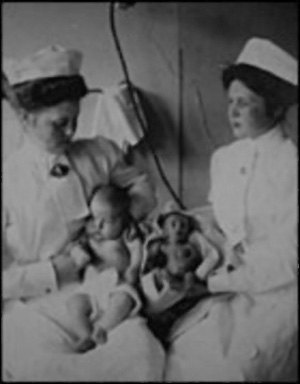 |
Minneapolis Pioneers and Soldiers Memorial Cemetery History Page Alley Article |
| Home | Burial Search | Friends | History | Photo Gallery | Visitor Information |
| Alley Articles |
|
This article originally appeared in the Phillips community's Alley Newspaper, July/August 2004.
Premature babies would seem to be the least likely people to be part of a world-wide movement. Yet, the Wonderland babies were precisely that. They were among the 80,000 premature infants who were treated in amusement parks and fairs in Europe and the United States between 1896 and 1944. Wonderland Amusement Park, which was located at Lake Street and 31 st Avenue, opened for business in late May, 1905. Wonderland, and other parks like it, were part of America 's love affair with technology and provided fair-goers with the opportunity to see the wonders of modern science in a carnival atmosphere. One of those wonders was the Infantorium, a hospital-like facility filled with incubators containing tiny babies who were born prematurely. The babies were not advertised as entertainment but rather as a “scientific exhibit of the modern method of saving the prematurely born babies.” For a small fee, fair-goers could see this wonder of technology—a shiny glass and chrome incubator. At a time when fewer than 5% of all babies were born in hospitals, the opportunity to see a premature infant in an incubator was something worth paying to see. And ticket sales were important because they paid for staff salaries and the cost of supplies. Since parents were not charged, any child referred to the Infantorium by a physician was eligible for treatment, a novel idea in itself. This novel approach to treating premature infants started when Dr. Martin Couney, gave his first demonstration in Berlin 1896. The movement spread throughout Europe and arrived in America in time for the Pan American Expo in Buffalo, New York, in 1901. In late May 1905, just before Wonderland's Infantorium opened, Dr. Couney was in Minneapolis, offering his advice to the doctors in charge of it. They were waiting for the nurses, who had been specially trained in Paris or Berlin, to arrive.
Wonderland closed in 1912, a casualty of bad weather and slow ticket sales. The only part of the park, which once spanned 20 acres, that survives is the Infantorium. It has been converted into an apartment building and is located on the southeast corner of the intersection at 31 st Avenue and 31 st Street.
Next Article -> Caretaker's Cottage --- March 2006 |
|
©Friends of the Cemetery, 2005-2008 Contact us at history@friendsofthecemetery.org |
File last updated: Friday October 13, 2006 |
 Premature Babies were Displayed at Lake Street Amusement Park
Premature Babies were Displayed at Lake Street Amusement Park
 Dr. Couney's treatment regimen did not work for all of the babies, and eleven of those who did not survive are buried in Minneapolis Pioneers and Soldiers Memorial Cemetery. Nonetheless, it is estimated that 85% of the children who were treated using Dr. Couney's methods did survive. The principles that he espoused—filtered air, regulated temperatures, strict hygiene, and adequate nutrition—are common practice in neonatal wards today.
Dr. Couney's treatment regimen did not work for all of the babies, and eleven of those who did not survive are buried in Minneapolis Pioneers and Soldiers Memorial Cemetery. Nonetheless, it is estimated that 85% of the children who were treated using Dr. Couney's methods did survive. The principles that he espoused—filtered air, regulated temperatures, strict hygiene, and adequate nutrition—are common practice in neonatal wards today.